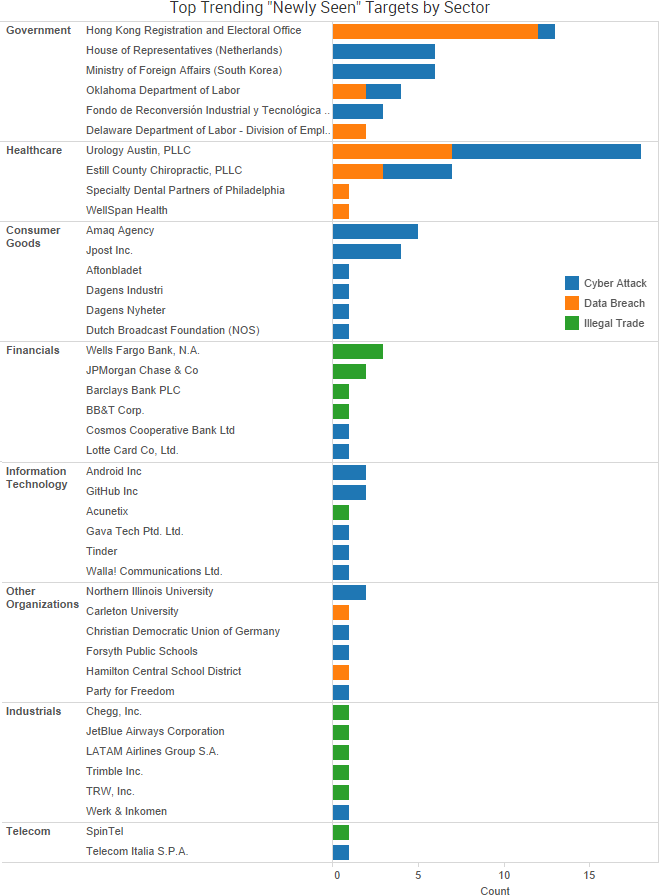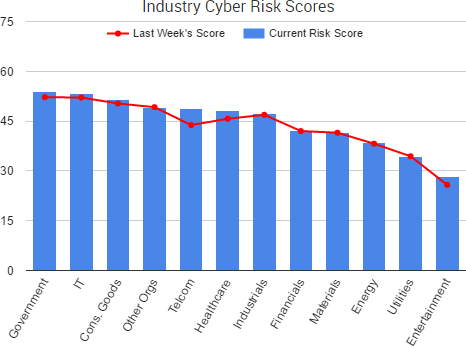The CIA remained as the top trending cybercrime target of the week as WikiLeaks released a third set of documents related to the agency. The new release includes 676 source code files for the CIA’s secret anti-forensic Marble Framework, which WikiLeaks said “is used to hamper forensic investigators and anti-virus companies from attributing viruses, trojans and hacking attacks to the CIA.”
 “The source code shows that Marble has test examples not just in English but also in Chinese, Russian, Korean, Arabic and Farsi,” WikiLeaks wrote in its announcement. “This would permit a forensic attribution double game, for example by pretending that the spoken language of the malware creator was not American English, but Chinese, but then showing attempts to conceal the use of Chinese, drawing forensic investigators even more strongly to the wrong conclusion.”
“The source code shows that Marble has test examples not just in English but also in Chinese, Russian, Korean, Arabic and Farsi,” WikiLeaks wrote in its announcement. “This would permit a forensic attribution double game, for example by pretending that the spoken language of the malware creator was not American English, but Chinese, but then showing attempts to conceal the use of Chinese, drawing forensic investigators even more strongly to the wrong conclusion.”
The fact that an intelligence agency would have tools to cover its tracks is hardly surprising. However, it appears that WikiLeaks will continue to leak CIA documents for the foreseeable future, and those leaks may have yet-to-be known implications for governments, tech companies, and cybercriminal actors. After the initial CIA leak in early March, WikiLeaks tweeted that is has released less than one percent of its Vault7 series.
Another recurring story in these roundups is the Mirai botnet, and researchers said this week that a new variant is likely behind a 54-hour long DDoS attack that targeted a U.S. college. The attack peaked at 37,000 requests per second, the most Incapsula has seen out of any Mirai botnet. The company said 56 percent of all IPs used in the attack belonged to DVRs manufactured by the same vendor. IoT devices continue to make headlines for vulnerabilities – including certain devices that were allegedly targeted by the CIA – and this past week saw new warnings of methods for hacking smart televisions as well as a vulnerability in an Internet-connected washer-disinfector. As SurfWatch Labs chief security strategist Adam Meyer recently wrote, IoT devices have potentially become the largest digital footprint of organizations that is not under proper security management.

Other trending cybercrime events from the week include:
- Data breaches expose more credentials: A hacker has stolen the email addresses and MD5-hashed passwords of 6.5 million accounts from Dueling Network, a now-defunct Flash game based on the Yu-Gi-Oh trading card game. Although the game was shut down in 2016, the forum continued to run until recently. Nearly 14 million stolen and fake email credentials from the 300 largest U.S. universities are for sale on the dark web, a rise from only 2.8 million last year, according to the nonprofit Digital Citizens Alliance. The stolen email addresses and passwords sell from $3.50 to $10 each.
- Warnings of skimming and keylogging devices: Carleton University in Ottawa said it discovered USB keylogging devices on six classroom computers during a routine inspection, and the university is urging staff and students to change passwords for any accounts they may have accessed from classroom computers. The San Bernardino County Sheriff’s Department has received more than 70 reports of credit card fraud tied to a suspected card skimming device in Big Bear. A Romanian citizen pleaded guilty to a scheme to defraud customers of Bank of America and PNC Bank via ATM skimming.
- Ransomware notifications continue: Urology Austin has notified 200,000 patients of a January 22 ransomware attack that may have compromised their information. Ransomware encrypted files belonging to Forsyth Public Schools and information such as lesson plans and schedules stored by teachers on the district server is likely lost due to the incident. Estill County Chiropractic is notifying 5,335 patients of unauthorized access to its system and a ransomware infection that may have compromised their personal information. Ransomware was found on the computer systems of the Tweede Kamer, the lower house of Dutch parliament.
- Former employee causes serious problems: A former IT administrator of the Lucchese Boot Company pleaded guilty to hacking the servers and cloud accounts of his employer after he was fired, and the company claims it lost $100,000 in new orders in addition to the extra IT costs it had to endure due to the attack. According to the complaint, the former employee logged into an administrator account after being fired and proceeded to shut down the corporate email and application servers, deleted files on the servers to block any attempts for a reboot, and then began shutting down or changing the passwords on the company’s cloud accounts.
- Other notable cybercrime events: The personal information of 3.7 million Hong Kong voters and the city’s 1,200 electors may have been compromised when two laptops were stolen. Approximately 95,000 individuals who applied online for a job at McDonald’s in Canada had their information compromised due to unauthorized access to the company’s database. Multiple employees of the Washington University School of Medicine fell for phishing emails designed to steal credentials used to access their email. While investigating a data breach related to employees’ W-2 forms, Daytona State College discovered a second data breach involving student financial aid forms. A Russian citizen has pleaded guilty to his role in helping spread malware known as “Ebury,” which harvested log-on credentials from infected computer servers, allowing the criminal enterprise behind the operation to operate a botnet comprising tens of thousands of infected servers throughout the world.
SurfWatch Labs collected data on many different companies tied to cybercrime over the past week. Some of those “newly seen” targets, meaning they either appeared in SurfWatch Labs’ data for the first time or else reappeared after being absent for several weeks, are shown in the chart below.

Cyber Risk Trends From the Past Week
 The password manager LastPass has addressed a series of vulnerabilities that were discovered by Google Project Zero researcher Tavis Ormandy, including one now-patched “unique and highly sophisticated” client-side vulnerability in the LastPass browser extension.
The password manager LastPass has addressed a series of vulnerabilities that were discovered by Google Project Zero researcher Tavis Ormandy, including one now-patched “unique and highly sophisticated” client-side vulnerability in the LastPass browser extension.
In a March 31 update, LastPass advised its users to ensure they are running the latest version (4.1.44 or higher) of the extension so that they are protected.
The vulnerability, which could be exploited to steal data and manipulate the LastPass extension, required first luring a user to either a malicious website or a website running malicious adware and then taking advantage of the way LastPass behaves in “isolated worlds,” the company said.
An isolated world is a JavaScript execution environment that shares the same DOM (Document Object Model) as other worlds, but things like variables and functions are not shared. LastPass explained:
The separation is supposed to keep both sides safer from external manipulation. In some cases, these variables can influence the logic of the content script. It is difficult to inject arbitrary values into JavaScript using this technique. But in a particularly clever move, the report demonstrated that arbitrary strings could be injected, and one of these was enough to trick the extension into thinking it was executing on lastpass.com. By doing so, an attacker could manipulate the LastPass extension into revealing the stored data of that user, and launch arbitrary executables in the case of the binary version.
Fixing the issue required “a significant change” to the browser extensions and LastPass urges other extension developers to look for this pattern in their code and ensure that they are not vulnerable to a similar attack.
The patch came just 10 days after LastPass issued another update to address two other issues discovered by Ormandy that could allow the attacker to potentially retrieve and expose information from the LastPass account, such as user’s login credentials.
The incident serves as a reminder that vulnerabilities continue to be discovered in a variety of products, including the tools used to help keep individuals and organizations safe. Having a full accounting of an organization’s technology infrastructure as well as policies and procedures to track new vulnerabilities and patch software is one of the most effective ways to combat malicious actors who rely on exploiting well-known vulnerabilities.

